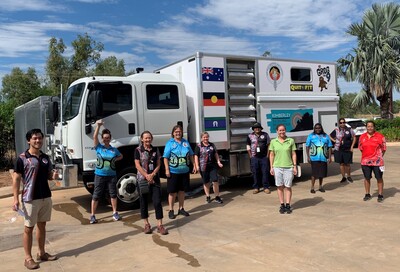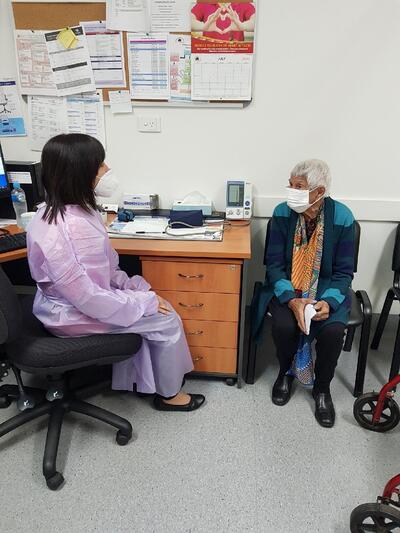Keeping Australia's Indigenous communities COVID safe

Across Australia, Aboriginal and Torres Strait Islander communities have been faring well when it comes to COVID-19. Nationwide there have been just 151 cases and zero deaths* — a rate of infection six times lower than the non-Indigenous population.
What strategies are helping to keep Indigenous Australians safe? Hospital + Healthcare spoke to National Aboriginal Community Controlled Health Organisation (NACCHO) Medical Advisor Dr Jason Agostino, who discussed some of the key measures that are working to successfully protect these communities.
“The main driving force behind the safety strategies for Aboriginal and Torres Strait Islander communities has been the leadership from these communities,” Dr Agostino explained. “At the very start of the pandemic, Indigenous leaders requested that the Australian Government establish a COVID-19 advisory group, leading to the formation of the Aboriginal and Torres Strait Islander Advisory Group on COVID-19 in early March 2020.”
Members of the Group (the Taskforce) sought to develop and deliver a National Management Plan to protect Aboriginal and Torres Strait Islander communities and save lives. The Taskforce is co-chaired by NACCHO and the Department of Health.
Health messaging
A wide range of measures have been implemented to protect Aboriginal and Torres Strait Islander communities from COVID-19 across Australia. Most of Australia’s Aboriginal and Torres Strait Islander population lives in cities and country towns — in areas that have witnessed cases of COVID-19.
Dr Agostino explained that messaging has been a critical safety component, by relaying important COVID-19 health information to Indigenous communities. Sharing messages under the tagline ‘Keep our Mob safe’ has been encouraged throughout the community, with core focus points of good hygiene, protecting communities and Elders, and staying connected.
A range of material has been developed in partnership with a First Nations media communications agency including video messages, brochures, posters and a regular eNewsletter. This has been done in conjunction with mass media advertising including print, radio, digital and social advertising which has been specifically developed to be inclusive of Aboriginal and Torres Strait Islander audiences.
Key topics of focus in public communications include:
- Understanding what COVID-19 is and how it spreads.
- How to protect families, communities and the elderly from the virus.
- Encouraging access to support services, in particularly mental health, medical appointments for chronic illness management and domestic violence safety.
- Protecting family and community from the impacts of influenza.
Rapid testing
The establishment of rapid COVID-19 PCR point-of-care testing for remote and rural Indigenous communities has also played a key role in keeping Indigenous communities safe. Access to rapid-testing facilities allows quick identification of COVID-19 cases to prevent spread, particularly in areas where infrastructure and/or ability to self-isolate is compromised due to lack of housing and crowding.
The Taskforce reported that, as at 13 December 2020, 86 health services are participating in the program, with a further 67 services acting as spoke sites, increasing the reach of the program to over 150 remote communities.
25 remote communities around the Kununurra area to provide health services during COVID 19 pandemic.
GP-led respiratory clinics
The Australian Government has allocated $206.7 million to establish more than 100 general-practice-led respiratory clinics (GPRCs) across Australia, including in urban, rural and regional areas. GPRCs are designed to provide advice and health care to all Australians with mild-to-moderate COVID-19 symptoms while reducing the pressure on hospitals and the risk of transmission by visits to regular GP clinics.
A Taskforce update in December 2020 reported that 150 GPRCs had opened across the country, of which 23 are Aboriginal Community Controlled Health Organisations (ACCHOs). These ACCHOs have seen mainly non-Indigenous patients throughout the pandemic, but their establishment means there are options for Aboriginal and Torres Strait Islander people to get tested at places that are familiar and culturally safe.
Restricted access to remote communities
Early lockdown and restricted access to remote Indigenous communities — at the request of these communities — was implemented to protect community members from the spread of coronavirus. All non-essential visitors to remote communities have ceased. Those returning to communities are required to self-isolate for 14 days in line with health guidelines.
In the event of positive cases in remote communities, provisions have been made to evacuate early cases to enable an effective response and limit exposure to other community members.
Vaccination
The Australian Technical Advisory Group on Immunisation (ATAGI) acknowledged that Aboriginal and Torres Strait Islander people have an increased risk of acquiring and developing serious illness from COVID-19 due to factors including having a high rate of chronic health conditions and a greater chance of living in communities where crowded living conditions exist.
Aboriginal and Torres Strait Islander adults aged 55 years and above will be eligible for the vaccine in the second priority group (Phase 1b) of the National Rollout Strategy; Indigenous Australians aged 18–54 years will receive the COVID-19 vaccine in Phase 2a of the rollout. GPRCs and ACCHOs will be key vaccine provider sites.
The approach to Indigenous community safety during the COVID-19 pandemic is multi-factorial, with additional strategies including grants for remote community organisations to support planning and preparedness activities; online training modules for healthcare workers; and the expansion of telehealth. The community-led approach, based on accurate health information, has been successful in assuring the safety of Australia’s Aboriginal and Torres Strait Islander population.
Remote laundries target preventable disease in NT communities
A new community laundry has launched in Borroloola, part of a program seeking to curb preventable...
Eye care partnership looks to support First Nations optometrists
A new scholarship initiative will support Aboriginal and/or Torres Strait Islander optometrists...
A Day in the Life of a mobile optometrist
Linda Nguyen is the owner and founder of mobile optometrist practice Care Optometry and was a...







![[New Zealand] Transform from Security Awareness to a Security Culture: A Vital Shift for SMB Healthcare — Webinar](https://d1v1e13ebw3o15.cloudfront.net/data/89856/wfmedia_thumb/..jpg)
![[Australia] Transform from Security Awareness to a Security Culture: A Vital Shift for SMB Healthcare — Webinar](https://d1v1e13ebw3o15.cloudfront.net/data/89855/wfmedia_thumb/..jpg)




